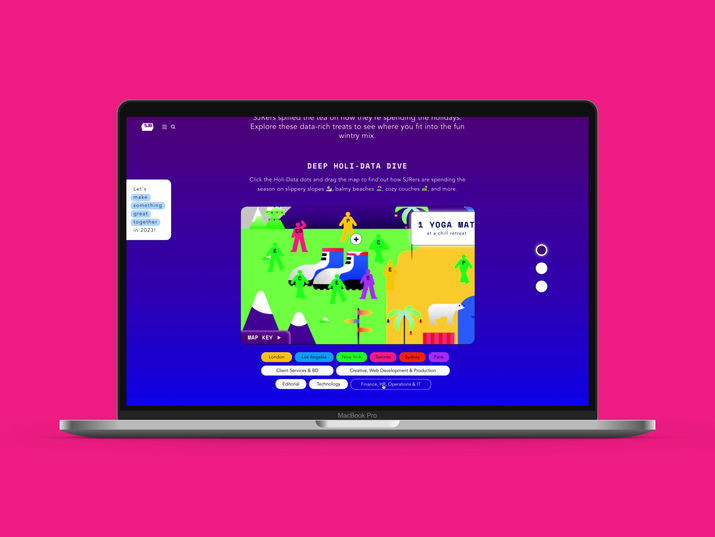
Creative strategy is a lot like pizza
How knowing your audience and proper planning delivers effective creative solutions.
Rome wasn't built in a day.
We all agree with the notion that it takes time to create something great. While keeping your perspective on the end goal is good, let’s not forget the second half of John Heywood’s notable words, “Rome wasn’t built in a day, but they were laying bricks every hour.” And there it is, emphasizing the small, thoughtful steps necessary to create a successful result. So why have we removed the second half of this phrase?
People like to visualize the result without considering the heavy lifting or fundamental building blocks it takes to create something freaking awesome. Why is that? Because it’s not easy or simple and it takes a dedicated team of hardworking, agile, and motivated humans to pull it off successfully. Time is necessary for great creation, but even more so focused energy and strategic planning is how you ultimately achieve creative solutions as great as Rome — or I don't know, since we’re talking about Italy, how about pizza?
Who wants pizza? Everyone.
Pizza is wonderful, and there aren’t many people that would disagree with that statement. Another thing about pizza is it doesn’t magically appear in front of you, or fall from the sky into your lap — wouldn’t that be great? Whether you’re ordering out, popping a frozen pie in the oven, or making it from scratch, there are people behind the pie taking the necessary steps to place that perfect cheesy slice into your hand. And when you dig deep and think about it, creative strategy is a lot like making pizza.
When creators approach a project, they must first think of who they’re making it for — the old ‘know your audience’ as they say — the problems that need to be solved, and the unique desires of that particular audience. These questions ultimately establish the fundamental building blocks for any creative project. First, we must break down the audience. For instance, you wouldn’t make a hearty meat-lovers pie for a group of hungry vegetarians, and you probably wouldn’t order twelve grilled pizzas with balsamic, onions, Gorgonzola, and arugula to satisfy the cravings of a group of picky preteens. But of course, there are pizzas for everyone, it just comes down to knowing your audience's preferences and needs. When your audience is fulfilled, you know you’ve successfully done your job and will leave them craving more.
Why would someone want pizza?
It may seem like a silly question, but let’s break it down. They’re probably hungry, you’d think, but maybe there’s more to it. What if the feeling of nostalgia was overwhelming them, and they missed the aroma of a freshly baked pie after moving from Naples to LA? Or perhaps they’ve never tried pizza before, are curious about all the fuss, and need to desperately taste their very first cheesy bite.
Now, think about those picky kids. They’re most likely at a birthday party, eager to hang out with their friends and eat free food they don’t hate chomping on. These problems must be approached differently to fulfill each of their needs.
When do they want it? Now.
After knowing and analyzing their specific problems, you must now think about how to deliver; unfortunately, that doesn’t happen overnight. For pizza, it can simply be just that, delivery. Given time allocation, this may be your only option. If you waited last minute and didn’t plan, all you can do is hope that the pizza arrives on time, is decent enough for the pizza indulgers, and meets their standards. Now, thinking about it… Wouldn’t you rather have a thoughtful plan to exceed those expectations? What if you gave your audience a better, more satisfying option that not only met their needs but enhanced their overall pizza-eating experience? Of course, this approach would take more time, thoughtfulness, and energy than simply picking up your phone and ordering from your local pizza joint. However, if you have people dedicating the necessary time and energy, it could be one of the best pizza experiences ever.
Let’s go back to those preteens — what if instead of ordering out, you created a fun build-you-own pizza station? Every kid is handed the opportunity to create their very own personalized pizza. You’ve solved the problem of picky eaters and replaced it with an interactive experience with positive outcomes that exceed your audience’s expectations. This process may look something like: creating a thorough grocery list, someone going shopping, another setting up the pizza station, baking each pie without burning them, and cleaning up the mess ultimately spending more time, money, and energy to bring it to life.
...but isn’t it worth the satisfaction? Is not witnessing the pure joy from typically hangry preteens worth the extra time? Isn't focused energy and strategic planning necessary to not only meet your audience's needs but exceed them? To keep them coming back for another slice? Yes, the answer is yes.
Final pizza thoughts:
We are faced with creative problems constantly, and we must solve them through strategic creative planning — because without that, we are not truly serving our audiences. Let's reject convenience simply because it is easier to visualize. Just like mouth-watering pizza, creative solutions don't magically appear in front of you. We must put in the work, and build a strong foundation to achieve great results. Now who wants pizza?
Hungry for more?



